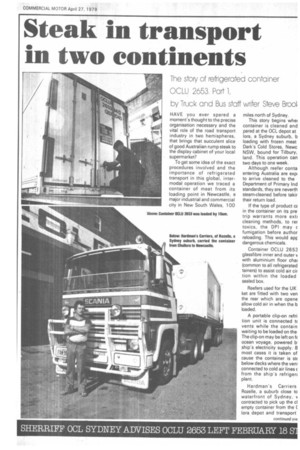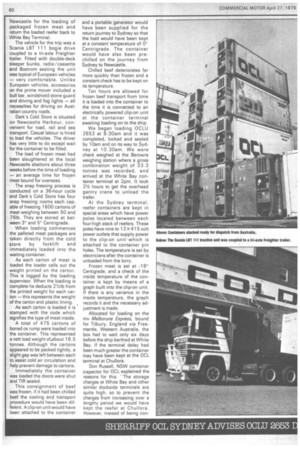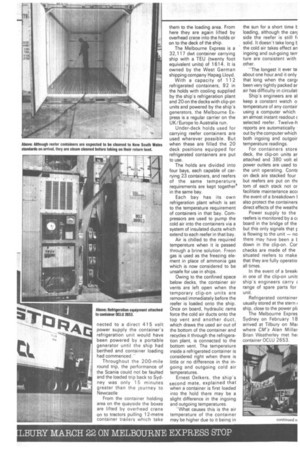Steak in transport in two continents
Page 61

Page 62

Page 63

If you've noticed an error in this article please click here to report it so we can fix it.
The story of refrigerated container OCLU 2653, Part 1, by Truck and Bus staff writer Steve Brad
HAVE you ever spared a moment's thought to the precise organisation necessary and the vital role of the road transport industry in two hemispheres, that brings that succulent slice of good Australian rump steak to the display cabinet of your local supermarket?
To get some idea of the exact procedures involved and the importance of refrigerated transport in this global, intermodal operation we traced a container of meat from its loading point in Newcastle, a major industrial and commercial city in New South Wales, 100 miles north of Sydney.
This story begins whei container is cleaned and pared at the OCL depot at bra, a Sydney suburb, b loading with frozen meat Dark's Cold Stores, Newc NSW, bound for Tilbury, land. This operation can two days to one week.
Although reefer conta entering Australia are exp, to arrive cleaned to the Department of Primary Ind standards, they are neverth steam-cleaned before takir their return load.
If the type of product eE in the container on its pre trip warrants more exti cleaning methods, to rer toxics, the DPI may c fumigation before author reloading. This would app dangerous chemicals.
Container OCLU 2652 glassfibre inner and outer v with aluminium floor chai (common to all refrigerated tainers) to assist cold air cir tion within the loaded sealed box.
Reefers used for the UK ket are fitted with two yen the rear which are opene allow cold air in when the b loaded.
A portable clip-on refri tion unit is connected tt vents while the contain waiting to be loaded on the The clip-on may be left on fc ocean voyage, powered b. ship's electricity supply. B most cases it is taken of
cause the container is sti below decks where the veni connected to cold air lines c from the ship's refrigeri plant.
Hardman's Carriers Rozelle, a suburb close tc waterfront of Sydney, v contracted to pick up the cl empty container from the ( lora depot and transport Newcastle for the loading of packaged frozen meat and return the loaded reefer back to White Bay Terminal.
The vehicle for the trip was a Scania LBT 111 bogie drive coupled to a tri-axle Freighter trailer. Fitted with double-deck sleeper bunks, radio/cassette and Bostrom seating the unit was typical of European vehicles — very comfortable. Unlike European vehicles, accessories on the prime mover included a bull bar, windshield stone guard and driving and fog lights — all necessities for driving on Australian country roads.
Dark's Cold Store is situated on Newcastle Harbour, convenient for road, rail and sea transport. Casual labour is hired to load the vehicles. The driver has very little to do except wait for the container to be filled.
The load of frozen meat had been slaughtered at the local Newcastle abattoirs about three weeks before the time of loading — an average time for frozen meat bound for overseas.
The snap freezing process is conducted on a 36-hour cycle and Dark's Cold Store has four snap freezing rooms each capable of freezing 1600 cartons of meat weighing between 50 and 751b. They are stored at between 3° and 5' Centrigrade.
When loading commences the palleted meat packages are taken directly from the cold store by forklift and immediately loaded into the waiting container.
As each carton of meat is loaded the loader calls out the weight printed on the carton, This is logged by the loading supervisor. When the loading is complete he deducts 21/21b from the printed weight for each carton —this represents the weight of the carton and plastic lining.
As each carton is loaded it is stamped with the code which signifies the type of meat inside.
A total of 475 cartons of boned ox rump were loaded into the container. This represented a nett load weight of.about 18.5 tonnes. Although the cartons appeared to be packed tightly, a slight gap was left between each to assist cold air circulation and help prevent damage to cartons.
Immediately the container was loaded the doors were shut and TIR sealed.
This consignment of beef was frozen; if it had been chilled beef the cooling and transport procedure would have been different. A clip-on unit would have been attached to the container
and a portable generator would have been supplied for the return journey to Sydney so that the load would have been kept at a constant temperature of 0° Centrigrade. The container would have also been prechilled on the journey from Sydney to Newcastle.
Chilled beef deteriorates far more quickly than frozen and a constant check has to be kept on its temperature.
Ten hours are allowed for frozen beef transport from time it is loaded into the container to the time it is connected to an electrically powered clip-on unit at the container terminal awaiting loading on to the ship.
We began loading OCLU 2653 at 8.30am and it was completed, locked and sealed by lOarn and on its way to Sydney at 10.30am. We were check weighed at the Berowra weighing station where a gross combination weight of 33.3 tonnes was recorded, and arrived at the White Bay container terminal at 2pm. It took 21/2 hours to get the overhead gantry crane to unload the trailer.
At the Sydney terminal, reefer containers are kept in special areas which have power poles located between each four-high stack of reefers. These poles have nine to 12X 415 volt power outlets that supply power to the clip-on unit which is attached to the container pin holes. The temperature is set by electricians after the container is unloaded from the lorry.
Frozen meat is set at -18° Centigrade, and a check of the
inside temperature of the con
tainer is kept by means of a graph built into the clip-on unit.
If there is any variance in the inside temperature, the graph records it and the necessary adjustment is made.
Allocated for loading on the my Melborune Express, bound
for Tilbury, England via Free mantle, Western Australia, the box had to wait only six days before the ship berthed at White Bay. If the terminal delay had been much greater the container may have been kept at the OCL terminal at Chullora.
Don Russell, NSW container inspector for OCL explained the reasons for this. "The storage charges at White Bay and other similar dockside terminals are quite high, so to prevent the charges from increasing over a
lengthy period we would have kept the reefer at Chullora. However, instead of being con
nected to a direct 415 volt power supply the container's refrigeration unit would have been powered by a portable generator until the ship had berthed and container loading had commenced " Throughout the 200-mile round trip, the performance of the Scania could not be faulted and the loaded trip back to Sydney was only 15 minutes greater than the journey to Newcastle From the container holding area on the quayside the boxes are lifted by overhead crane on to tractors pulling 12-metre container trailers which take them to the loading area. From here they are again lifted by overhead crane into the holds or on to the deck of the ship.
The Melbourne Express is a 32,117 dwt container carrying ship with a TEU (twenty foot equivalent units) of 1614. It is owned by the West German shipping company Hapag Lloyd.
With a capacity of 112 refrigerated containers, 92 in the holds with cooling supplied by the ship's refrigeration plant and 20 on the decks with clip-pn units and powered by the ship's generators, the Melbourne Express is a regular carrier on the UK/Europe to Australia run.
Under-deck holds used for carrying reefer containers are used wherever possible. But when these are filled the 20 deck positions equipped for refrigerated containers are put to use.
The holds are divided into four bays, each capable of carrying 23 containers, and reefers of the same temperature requirements are kept together'' in the same bay.
Each bay has its own refrigeration plant which is set to the temperature requirement of containers in that bay. Compressors are used to pump the cold air into the containers via a system of insulated ducts which extend to each reefer in that bay.
Air is chilled to the required temperature when it is passed through a brine solution. Freon gas is used as the freezing element in place of ammonia gas which is now considered to be unsafe for use in ships.
Owing to the confined space below decks, the container air vents are left open when the temporary clip-on units are removed immediately before the reefer is loaded onto the ship. Once on board, hydraulic rams force the cold air ducts onto the top vent and another duct, which draws the used air out of the bottom of the container and recycles it through the refrigeration plant, is connected to the bottom vent. The temperature inside a refrigerated container is considered right when there is little or no difference in the ingoing and outgoing cold air temperatures.
Ernest Oelkers, the ship's second mate, explained that when a container is first loaded into the hold there may be a slight difference in the ingoing and outgoing temperatures.
"What causes this is the air temperature of the container may be higher due to it being in the sun for a short time loading, although the carc side the reefer is still fi solid. It doesn't take long t the cold air takes effect an ingoing and out-going terr ture are consistent with other.
"The longest it ever ta about one hour.and it only that long when the cargi been very tightly packed ar air has difficulty in circulati Ship's engineers are al keep a constant watch o temperature of any contair using a computer which an almost instant readout E selected reefer. Twelve-h reports are automatically out by the computer which both ingoing and outgoir temperature readings.
For containers store deck, the clip-on units ar attached and 380 volt el power outlets are used to the unit operating. Contz on deck are stacked four but reefers are put on thE torn of each stack not or facilitate maintenance acci the event of a breakdown I also protect the containers direct effects of the weathE
Power supply to the reefers is monitored by a ci board in the bridge of the but this only signals that r is flowing to the unit — no there may have been a t down in the clip-on. Cor checks are made of the situated reefers to make that they are fully operatio all times.
In the event of a break in one of the clip-on units ship's engineers carry E range of spare parts for unit.
Refrigerated container usually stored at the stern ship, close to the power plr
The Melbourne Expres Sydney on February 18 arrived at Tilbury on Mai where CM's Alan Millar Brian VVeatherley met he container OCLU 2653.
















































































































































